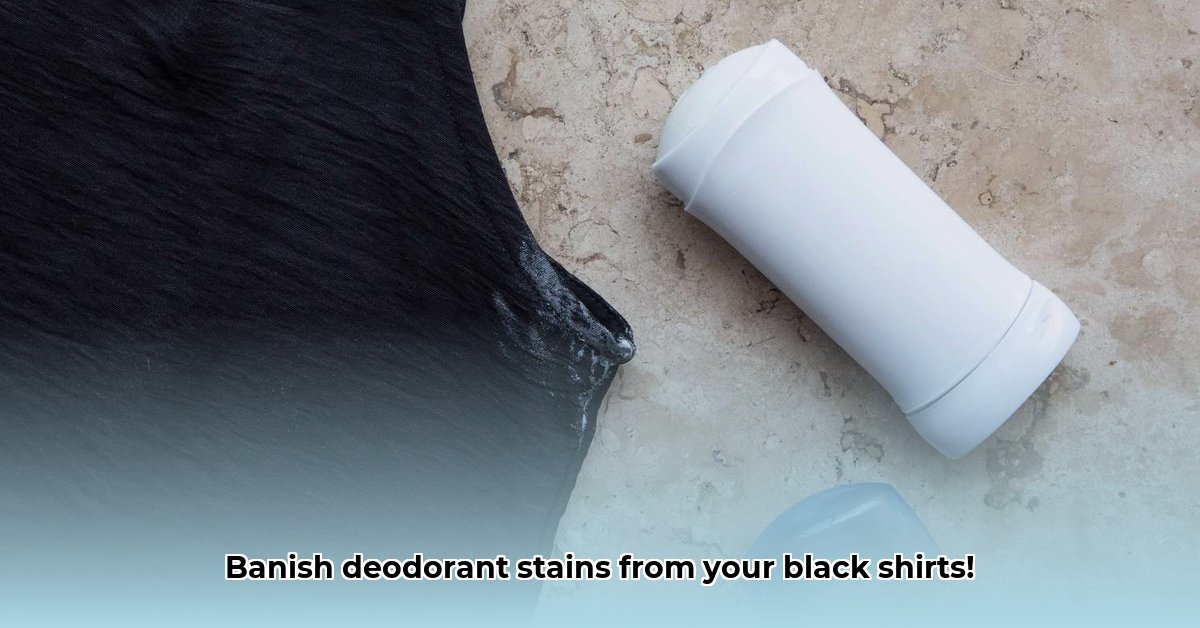Deodorant: a daily essential, yet a sneaky culprit behind those frustrating white marks on our favorite black shirts. Don’t let deodorant stains win! This guide offers a comprehensive strategy, from proactive prevention to targeted stain removal, ensuring your black wardrobe remains pristine. For more tips, check out this helpful guide on deodorant stain removal.
Prevention is Key: Stop Stains Before They Start
The best way to deal with deodorant stains? Prevent them altogether! These simple habits can save you time and frustration:
-
The Drying Game: Patience is your friend. Allow your deodorant to dry completely before dressing. This prevents transfer and minimizes buildup. Even a few extra minutes can make a world of difference.
-
Less is More: Apply a thin, even layer of deodorant. Excess product increases the likelihood of staining and product waste. Focus on coverage, not quantity.
-
Strategic Product Selection: Consider switching to a clear, gel-based antiperspirant or deodorant. These are formulated to minimize white marks, especially on dark fabrics. Look for products labeled “invisible” or designed for black clothing.
-
The Undershirt Shield: A simple undershirt acts as a protective barrier, intercepting deodorant before it reaches your outer layer. This is a particularly effective strategy for those prone to heavy perspiration or who favor solid stick deodorants.
Fresh Stain SOS: Act Quickly for Best Results
Spotted a fresh deodorant mark? Swift action is crucial. Try these immediate remedies:
-
Fabric-on-Fabric Friction: Gently rub the stained area with a clean nylon stocking, a used dryer sheet, or even another section of the shirt itself. This friction can dislodge freshly deposited deodorant.
-
Baking Soda Paste Power: Create a paste by mixing baking soda with a small amount of water. Apply the paste to the stain, let it sit for 5-10 minutes, then gently rub with a soft-bristled brush or clean cloth. Rinse thoroughly with cold water. Baking soda acts as a mild abrasive and deodorizer.
-
Reverse Rinse Rescue: Rinse the affected area with cold water from the backside of the fabric. This helps push the deodorant residue out of the fibers rather than further into them. Avoid hot water, as it can set the stain.
Battling Stubborn Stains: A Multi-Pronged Approach
Set-in stains require a more targeted strategy. Consider these methods:
-
Vinegar Soak Solution: Soak the stained area in a solution of equal parts white vinegar and cold water for 30-60 minutes. The acidity of vinegar helps break down the deodorant components. Rinse thoroughly afterward. Test this on an inconspicuous area first, as vinegar can affect certain dyes or delicate fabrics.
-
Baking Soda and Vinegar Tag Team: Combine the power of baking soda and vinegar. First, apply the baking soda paste as described above. After it sits, apply the vinegar solution. The fizzing action can help lift stubborn stains.
-
Commercial Stain Remover Support: Opt for a stain remover specifically designed for dark or colored fabrics. Always test on a hidden area first to ensure compatibility with the fabric. Follow the product instructions carefully.
-
Dish Soap Degreaser: Apply a small amount of clear liquid dish soap directly to the stain. Gently rub and let it sit for 15-20 minutes before laundering as usual. Dish soap is formulated to cut through grease and oil, which can be components of deodorant residue.
Fabric-Specific Care: Handle with Care
Always consult the garment’s care label before attempting any stain removal method. Delicate fabrics like silk, lace, or wool may require professional cleaning. For stubborn stains on these materials, it’s best to consult a dry cleaner.
Laundering: The Final Touch
After pre-treating, launder the garment according to the care label instructions. Use cold or lukewarm water and a mild detergent. Air drying is recommended, as the heat from a dryer can set any remaining stain. If you must use a dryer, choose the lowest heat setting.
A Word of Caution: Hydrogen Peroxide and Bleach
Avoid using hydrogen peroxide or chlorine bleach on black clothing. These are powerful bleaching agents that can cause discoloration or damage to dark fabrics.
By following these strategies, you can effectively combat deodorant stains and keep your black shirts looking their best. Remember, persistence is key! Don’t be discouraged if the stain isn’t completely eradicated on the first attempt. Repeat the process or try a different approach until you achieve the desired results.
- Master OSRS Heavy Ballista: Max Hit Guide - June 27, 2025
- OSRS Guardian Boots: Max Defense Guide - June 27, 2025
- Get Your OSRS Dragon Full Helm: Price Guide & Farming - June 27, 2025










